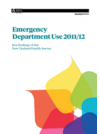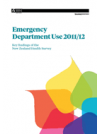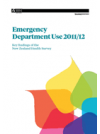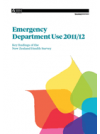This report focuses on differences in ED use over the past year for adults and children across population groups. It also reports on reasons for attending EDs, and whether respondents thought that they could have been treated by a medical centre, if one had been available, rather than by an ED. Patient experience of waiting times in ED is also presented.
Key Results
One in seven adults and children had used an emergency department (ED) in the previous 12 months. This represents approximately 483,000 adults and 126,000 children.There was a small increase in the proportion of adults (1%) and children (2%) who had used an ED from 2006/07 to 2011/12.
Less than one in 30 people (3.7%) reported that they had used an ED two or more times in the previous 12 months.The main reason for going to an ED was a serious or life-threatening condition.
Of adults who had used an ED in the past 12 months, nearly half (46%) reported that the main reason for their most recent visit was that their condition was life-threatening or serious.
The next most common main reasons for using an ED were reported as time of day/day of week (16%), having been sent by a general practitioner (GP) (13%) and having been taken by an ambulance/helicopter (13%).
One-quarter of adults and more than one-third of children who had used an ED reported that they could have been treated by a medical centre, if one was available.
This represents about 129,000 adults and 49,000 children.
Two out of three people reported waiting less than one hour to be treated in EDA small percentage of adults (6%) and the parents of children (4%) reported that they had to wait five or more hours to be treated.
Nearly one in three (31%) adults experienced poor communication about the length of time they would have to wait in ED.
More than half (55%) of adults did not mind the length of time they had to wait in ED.
The likelihood of people reporting that their wait in ED was ‘far too long’ is three times higher if communication about waiting time was poor or very poor (after adjusting for the actual waiting time).




